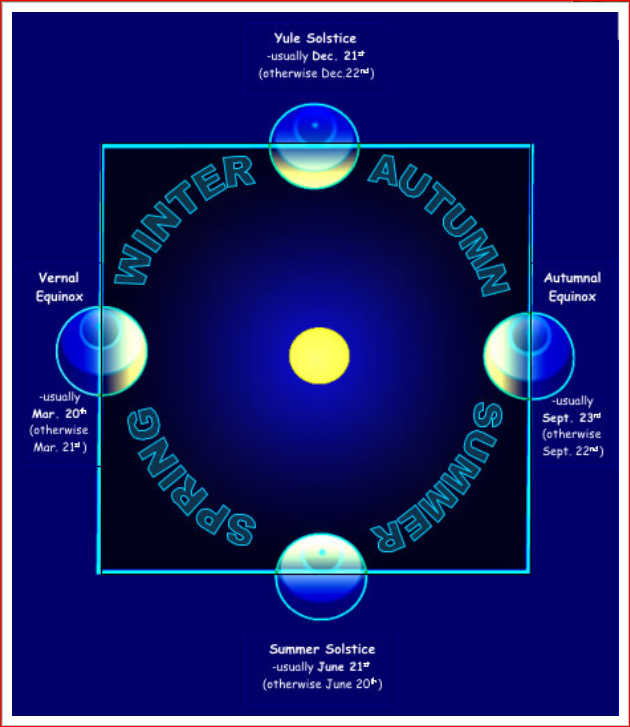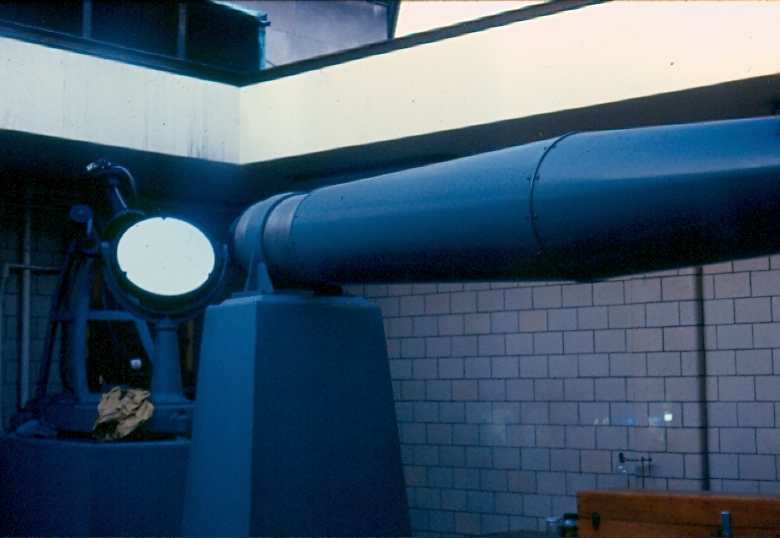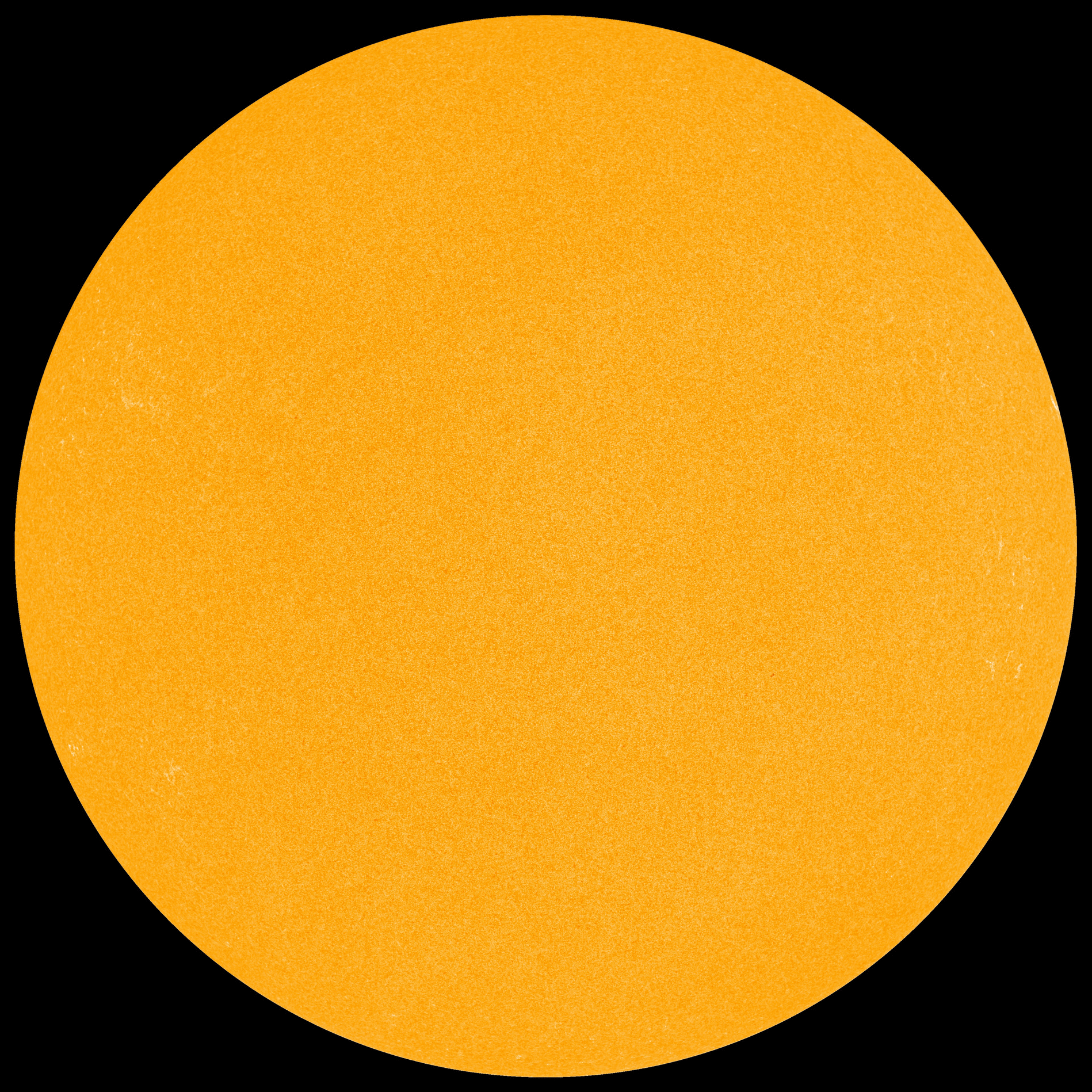
This diagram shows the position of the Earth, in relation to the Sun, at the time of the Summer Solstice, as well as the other solstice and equinoxes of the year. This year, June's Full Moon occurs on the day of the Summer Solstice in the Western Hemisphere.
(Graphic Source: ©1999, Eric G. Canali, former Floor Manager of Pittsburgh's original Buhl Planetarium and Institute of Popular Science and Founder of the South Hills Backyard Astronomers amateur astronomy club; permission granted for only non-profit use with credit to author.)
By Glenn A. Walsh
Reporting for SpaceWatchtower
This
year, the beginning of Summer in the Northern Hemisphere is marked
with a Full Moon. Both astronomical events occur on the same calendar
date in the Western Hemisphere.
For 2016, the season of Summer begins
in Earth's Northern Hemisphere (and the season of Winter begins in
the Southern Hemisphere) at the moment of the June Solstice: Monday
Evening, 2016 June 20 at 6:34 p.m. Eastern Daylight Saving Time (EDT)
/ 22:34 Coordinated Universal Time (UTC). The actual time of Full
Moon occurs Monday morning at 7:02 a.m. EDT / 11:02 UTC, the time of
the posting of this blog post. Although, technically, the Moon will
be in the Waning Gibbous Phase at the moment of the Summer Solstice,
it will, of course, look quite full.
A honey-hued-color Full Moon
(particularly at extreme northern latitudes) in June, particularly
around the time of the Summer Solstice, is considered the
"Honey-Moon." This honey-hued effect is due to the Full
Moon traveling low in the sky, very close to the southern horizon,
throughout the night.
This may have led to the traditional
term of "Honey-Moon," as weddings were traditionally held
in June when the good weather days of Summer would begin. The term
"Honey-Moon" can be traced as far back as 1552. At that
time, marriage was compared to the phases of the Moon, with a Full
Moon analogous to the wedding, the most happy time of a relationship.
Although the Full Moon does not occur
on the Summer Solstice every year, the June Full Moon does travel
close to the southern horizon, throughout the night, every year. As
this is the time when the Sun is the highest in the sky for the
entire year, this is also the time when the Moon is the lowest in the
sky for the entire year.
On days around the time of the Summer
Solstice this year, as the Full Moon sets early in the morning in the
southwest, the Sun rises at about the same time in the northeast, on
the opposite side of the celestial sphere. Likewise, when the Sun
sets in the evening in the northwest, at about the same time the Full
Moon will be rising in the southeast, on the opposite side of the
celestial sphere. And, the locations of the rising and setting of the
June Full Moon this year are approximately the same as the locations of
the rising and setting of the Sun around the time of the Winter
Solstice (December 20 to 22).
In etymology, the word solstice
comes from the Latin terms sol (Sun) and sistere (to
stand still). In ancient times, astronomers / astrologers / priests
recognized that on one day of the year (in the Northern Hemisphere,
near the day we now call June 21), the Sun would appear to reach its
highest point in the sky for the year. The motion of the Sun's
apparent path in the sky (what is known astronomically, today, as the
Sun's declination) would cease on this day, before appearing
to reverse direction.
Today, we know that, while the Sun does
have motions, it is actually the motion of the Earth tilted on its
axis 23.43715 degrees / 23 degrees 26 minutes 13.7 seconds away from
the plane of the ecliptic (Earth's orbital plane around the Sun),
while revolving around the Sun, that causes the Earth's seasons.
Hence, as the Earth arrives at the point in its orbit around the Sun,
when the north polar axis is most directly inclined toward the Sun,
this marks the Summer Solstice in the Northern Hemisphere and the
Winter Solstice in the Southern Hemisphere.
Alternately, the Winter Solstice in the
Northern Hemisphere occurs when the Earth reaches the point in its
orbit when the North Pole is most directly inclined away from the
Sun. And, conversely, at this time Summer begins in the planet's
Southern Hemisphere.
Although the Summer months in the
Northern Hemisphere are known for the year's warmest weather, the
Earth is actually at the point in its orbit farthest from the Sun
(astronomically known as the point of aphelion) around July 5;
the Earth's closest approach to the Sun (perihelion) each year
is around January 2. Solar radiation, and hence the heat from the
Sun, depends on the length of daylight and the angle of the Sun above
the horizon. The tilt of the planet's axis toward the Sun determines
the additional and more direct solar radiation received by a planet's
Northern or Southern Hemisphere, and hence, the warmer season of the
respective hemisphere.
The Vernal Equinox, when the season of
Spring begins in the Northern Hemisphere (and the season of Autumn
begins in the Southern Hemisphere), occurs between the Winter and
Summer Solstices when the Earth reaches the point in its orbit around
the Sun when the Earth's axis is inclined neither toward nor away
from the Sun. Likewise, when the Earth reaches the point in its orbit
around the Sun, between the Summer and Winter Solstices, when the
Earth's axis is inclined neither toward nor away from the Sun, this
is known as the Autumnal Equinox (beginning of Fall or Autumn) in the
Northern Hemisphere; at this time Spring begins in the Southern
Hemisphere. And, half-way between the beginning points of each season
are Cross-Quarter Days, each related to traditional holidays:
Groundhog Day (February 2), May Day (May 1), Lammas Day
(traditionally, the first harvest festival of the year on August 1),
and Halloween (October 31).
In ancient times, the Summer Solstice
was known as Midsummer Day, in early calendars observed around June
24. Such early European celebrations were pre-Christian in origin.
Many will associate this ancient holiday with the famous William
Shakespeare play, “A Midsummer Night's Dream.” Some speculate
that the play was written for the Queen of England, to celebrate the
Feast Day of Saint John.
As with the Roman Catholic Church's
decision to Christianize the pagan Winter Solstice festivals with the
introduction of Christmas Day on December 25, the Church began to
associate the Midsummer festivals with the Nativity of Saint John the
Baptist on June 24. In the Bible, the Gospel of Saint Luke implies
that John was born six months before the birth of Jesus, although no
specific birth dates are given.
In
addition to the Summer Solstice Full Moon being considered the
“Honey-Moon,” to the Algonquin Indians of North America, the June
Full Moon was known as the Strawberry Moon. This was due to the
relatively short harvest season for strawberries, which always came
in June.
In the Northern Hemisphere, the June Full Moon is also known as the Flower Moon and the Corn-Planting Moon. In Europe, the June Full Moon was known as the Rose Moon.
In the Southern Hemisphere, where the season of Winter is about to begin, the June Full Moon is known as the Oak Moon, Cold Moon, and Long-Night's Moon.
In the Northern Hemisphere, the June Full Moon is also known as the Flower Moon and the Corn-Planting Moon. In Europe, the June Full Moon was known as the Rose Moon.
In the Southern Hemisphere, where the season of Winter is about to begin, the June Full Moon is known as the Oak Moon, Cold Moon, and Long-Night's Moon.
Slooh Community Observatory live web-cast of Full Moon rising on the Summer Solstice - Monday Evening, 2016 June 20, 8:00 to 9:30 p.m. EDT / June 21, 0:00 to 1:30 UTC:
Link >>> http://live.slooh.com/stadium/live/june-solstice-full-moon
More on the Summer Solstice -
Link 1 >>> http://scienceworld.wolfram.com/astronomy/SummerSolstice.html
Link 2 >>> http://en.wikipedia.org/wiki/Summer_solstice
More on the Season of Summer: Link >>> http://en.wikipedia.org/wiki/Summer
More on the history of Midsummer: Link >>> http://en.wikipedia.org/wiki/Midsummer
Summer "Solstice Day" Annual Free-of-Charge Day, 1985 to 1991, at Pittsburgh's original Buhl Planetarium and Institute of Popular Science (a.k.a. Buhl Science Center):
Link >>> http://spacewatchtower.blogspot.com/2015/06/snowballs-on-first-day-of-summer.html
Special Thanks: Eric G. Canali, former Floor Manager of Pittsburgh's original Buhl Planetarium and Institute of Popular Science and Founder of the South Hills Backyard Astronomers amateur astronomy club.
Source:
Glenn A. Walsh Reporting for SpaceWatchtower, a project of Friends of
the Zeiss.
2016 June 20.

2016: 75th Year of Pittsburgh's Buhl Planetarium Observatory
Link >>> http://spacewatchtower.blogspot.com/2016/01/astronomical-calendar-2016-january.html
Like This Post? - Please Share!
Want to receive SpaceWatchtower blog posts in your inbox ?
Send request to < spacewatchtower@planetarium.cc >..
gaw
Glenn A. Walsh, Project Director,
Friends of the Zeiss < http://buhlplanetarium.tripod.com/fotz/ >
Electronic Mail - < gawalsh@planetarium.cc >
SpaceWatchtower Blog: < http://spacewatchtower.blogspot.com/ >
Also see: South Hills Backyard Astronomers Blog: < http://shbastronomers.blogspot.com/ >
Barnestormin: Writing, Essays, Pgh. News, & More: < http://www.barnestormin.blogspot.com/ >
About the SpaceWatchtower Editor / Author: < http://buhlplanetarium2.tripod.com/weblog/spacewatchtower/gaw/ >
SPACE & SCIENCE NEWS, ASTRONOMICAL CALENDAR:
< http://buhlplanetarium.tripod.com/#news >
Twitter: < https://twitter.com/spacewatchtower >
Facebook: < http://www.facebook.com/pages/SpaceWatchtower/238017839577841?sk=wall >
Author of History Web Sites on the Internet --
* Buhl Planetarium, Pittsburgh:
< http://www.planetarium.cc >
* Adler Planetarium, Chicago:
< http://adlerplanetarium.tripod.com >
* Astronomer, Educator, Optician John A. Brashear:
< http://johnbrashear.tripod.com >
* Andrew Carnegie & Carnegie Libraries:
< http://www.andrewcarnegie.cc >
* Civil War Museum of Andrew Carnegie Free Library:
< http://garespypost.tripod.com >
* Duquesne Incline cable-car railway, Pittsburgh:
< http://inclinedplane.tripod.com >
* Public Transit:
< http://andrewcarnegie2.tripod.com/transit >

2016: 75th Year of Pittsburgh's Buhl Planetarium Observatory
Link >>> http://spacewatchtower.blogspot.com/2016/01/astronomical-calendar-2016-january.html
Like This Post? - Please Share!
Want to receive SpaceWatchtower blog posts in your inbox ?
Send request to < spacewatchtower@planetarium.cc >..
gaw
Glenn A. Walsh, Project Director,
Friends of the Zeiss < http://buhlplanetarium.tripod.com/fotz/ >
Electronic Mail - < gawalsh@planetarium.cc >
SpaceWatchtower Blog: < http://spacewatchtower.blogspot.com/ >
Also see: South Hills Backyard Astronomers Blog: < http://shbastronomers.blogspot.com/ >
Barnestormin: Writing, Essays, Pgh. News, & More: < http://www.barnestormin.blogspot.com/ >
About the SpaceWatchtower Editor / Author: < http://buhlplanetarium2.tripod.com/weblog/spacewatchtower/gaw/ >
SPACE & SCIENCE NEWS, ASTRONOMICAL CALENDAR:
< http://buhlplanetarium.tripod.
Twitter: < https://twitter.com/spacewatchtower >
Facebook: < http://www.facebook.com/pages/
Author of History Web Sites on the Internet --
* Buhl Planetarium, Pittsburgh:
< http://www.planetarium.
* Adler Planetarium, Chicago:
< http://adlerplanetarium.
* Astronomer, Educator, Optician John A. Brashear:
< http://johnbrashear.tripod.com >
* Andrew Carnegie & Carnegie Libraries:
< http://www.andrewcarnegie.
* Civil War Museum of Andrew Carnegie Free Library:
< http://garespypost.tripod.com >
* Duquesne Incline cable-car railway, Pittsburgh:
< http://inclinedplane.tripod.
* Public Transit:
< http://andrewcarnegie2.tripod.


